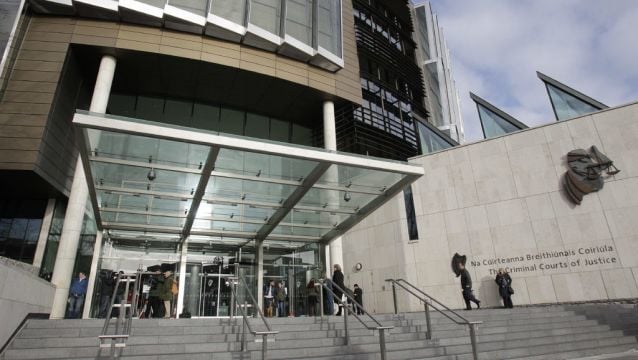A Kerry pimp who was jailed for 11 years for twice raping a sex worker and sending her graphic messages over Snapchat to prevent her from giving evidence will stay in jail after he failed in his bid to overturn his conviction.
Emmet O'Connor (30) from Shronemore, Rathmore, Co Kerry, was found unanimously guilty by a jury at the Central Criminal Court in December 2020 of two counts of rape as well as organising prostitution and intimidating a witness by sending her a drawing of a headless woman hanging upside-down from a tree.
He had denied all charges.
In April 2021, Mr Justice Michael White sentenced O'Connor to eight years' imprisonment for rape and anal rape, to two years for organising prostitution - to run consecutively with the rape sentences - and to another consecutive year for the intimidation offence.
At his trial, the jury of six men and six women heard evidence that O’Connor told gardaí that he had rough sex with the victim at her home but insisted it was consensual and typical of their sexual relationship.
The woman told the jury that she and O’Connor had consensual rough sex a year earlier but that on September 25th, 2017, she did not consent and was crying and begging him to stop.
The woman told the trial of how he grabbed her, putting her over his shoulders and brought her upstairs in her home, threw her on the bed and twice raped her, ignoring her pleas for him to stop.
O'Connor later sent Snapchat messages depicting a naked male with wearing a crown and holding up a woman's severed head with the words "karma" and "suffer" attached.
Cannon ball
He further sent images of a decapitated female body and a cannon firing a cannon ball with the words "fresh" and "skank" attached above the sentence "I guess it takes a special type of rape victim to want to stay close to her rapist".
In dismissing the appeal on Wednesday, Ms Justice Tara Burns said the Court of Appeal rejected the appellant's submission that the evidence of both the complainant's sister and a Ruhama counsellor together amounted to a repetition of complaint that could have prejudiced O'Connor.
Ms Justice Burns said the complaint to the victim's sister "simply recorded the fact that the complainant had been raped, whereas the second complaint gave further detail as to what had occurred".
Ms Justice Burns said the complaints were not repetitive or similar in nature and that, "of importance, the complaints were made in very close proximity to each other and the incident itself".
Ms Justice Burns said the two complaints were "significant in terms of assessing the consistency of the overall complaint made" and that their probative value outweighed any prejudicial effect complained of by the appellant.
"The court does not accept this proposition," said Ms Justice Burns. "The trial judge's direction in relation to recent complaint evidence was clear. An error does not arise in the manner in which the trial judge directed the jury," said Ms Justice Burns.
Regarding the ground of appeal concerning the forensic evidence, Ms Justice Burns said the investigating guard told the trial she had mistakenly believed that the complainant's clothing had been washed before she gave them to the investigating team - a situation which would not necessitate forensic analysis.
On foot of the investigating guard's evidence the clothing was then tested and admitted into evidence, albeit three years after the rapes.
Ms Justice Burns said the issue of the forensic testing of the clothing became a "live issue" for the defence in the case, even though there was no presence of semen found.
The complainant had told the court that O'Connor had worn a condom during the rapes and taken it with him, which he denied.
Ms Justice Burns said the Court of Appeal did not see any error with how the trial judge dealt with the "unusual situation which had arisen".
Forensic analysis
"The forensic analysis was still capable of taking place. Having been conducted, it was appropriate that the results of the examination be adduced in evidence," said Ms Justice Burns.
"The question posed by the appellant to the effect that it was not known what the result of that forensic analysis would have been was now answered. Furthermore, the appellant could either have requested the forensic analysis or have obtained the services of another expert. No prejudice arose for the appellant in this regard," said Ms Justice Burns.
Ms Justice Burns said the Snapchat posts at issue were "self-evidently of a very concerning nature" and said that O'Connor had acknowledged they were directed at the complainant.
Ms Justice Burns said the trial judge correctly directed the jury in relation to the constituent elements of the offence of intimidation. Ms Justice Burns then dismissed all grounds of appeal against the convictions.
At the Court of Appeal, Michael Lynn SC, for O'Connor, had submitted that the trial judge erred in allowing the evidence of two witnesses to go before a jury without a sufficient warning that their evidence went only towards the consistency of the complaint and not towards its corroboration.
Mr Lynn said that another ground of appeal was the introduction into the trial of late forensic evidence, after an error was noticed by gardaí that an analysis had not been compiled regarding the woman's underwear.
Mr Lynn said his client felt a "serious grievance" in the late introduction of the evidence in the trial in the interest of fairness.
"It was too late. The perception is that it is unfair, and we had put our best foot forward," submitted Mr Lynn.
Mr Lynn said the witness intimidation amounted to a Snapchat picture of a drawing done by O'Connor that the jury had questioned.
Mr Lynn said the judge did not adequately explain the possible issue of O'Connor's intent when sending the message.







